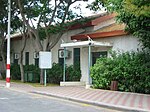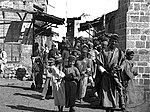Rosh HaAyin South railway station
Defunct railway stations in IsraelRailway stations in Central District (Israel)

Rosh HaAyin South railway station is a railway station near Rosh HaAyin, Israel. Despite the name, it is located north-west of the city, near the historic site of Antipatris (Tel Afek). The station no longer serves passengers, but it remains operational as a freight terminal, and there are plans to reinstate the passenger service.
Excerpt from the Wikipedia article Rosh HaAyin South railway station (License: CC BY-SA 3.0, Authors, Images).Rosh HaAyin South railway station
444, Drom HaSharon Regional Council Rambam
Geographical coordinates (GPS) Address Nearby Places Show on map
Geographical coordinates (GPS)
| Latitude | Longitude |
|---|---|
| N 32.104166666667 ° | E 34.934722222222 ° |
Address
444
4851136 Drom HaSharon Regional Council, Rambam
Center District, Israel
Open on Google Maps










